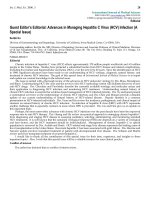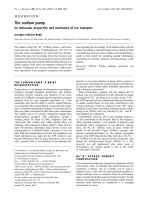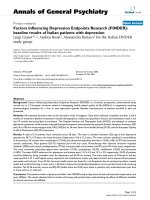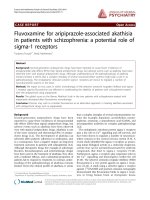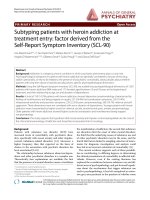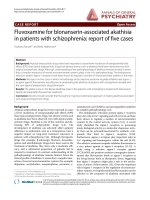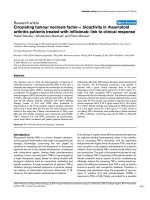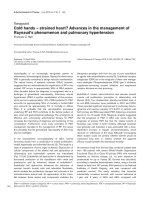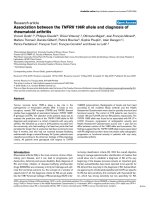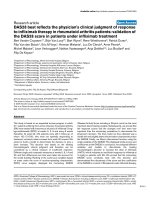Báo cáo y học: "Elderly patients undergoing mechanical ventilation in and out of intensive care units: a comparative, prospective study of 579 ventilations" pot
Bạn đang xem bản rút gọn của tài liệu. Xem và tải ngay bản đầy đủ của tài liệu tại đây (474.77 KB, 8 trang )
Lieberman et al. Critical Care 2010, 14:R48
/>Open Access
RESEARCH
BioMed Central
© 2010 Lieberman et al.; licensee BioMed Central Ltd. This is an open access article distributed under the terms of the Creative Com-
mons Attribution License ( which permits unrestricted use, distribution, and reproduc-
tion in any medium, provided the original work is properly cited.
Research
Elderly patients undergoing mechanical
ventilation in and out of intensive care units: a
comparative, prospective study of 579 ventilations
David Lieberman*
1,2,3
, Liat Nachshon
2,3
, Oleg Miloslavsky
2,3
, Valery Dvorkin
2,3
, Avi Shimoni
2,3
, Julian Zelinger
3,4
,
Michael Friger
5
and Devora Lieberman
2,3,6
Abstract
Introduction: Many mechanically ventilated elderly patients in Israel are treated outside of intensive care units (ICUs).
The decision as to whether these patients should be treated in ICUs is reached without clear guidelines. We therefore
conducted a study with the aim of identifying triage criteria and factors associated with in-hospital mortality in this
population.
Methods: All mechanically invasive ventilated elderly (65+) medical patients in the hospital were included in a
prospective, non-interventional, observational study.
Results: Of the 579 ventilations, 283 (48.9%) were done in ICUs compared with 296 (51.1%) in non-ICU wards. The
percentage of ICU ventilations in the 65 to 74, 75 to 84, and 85+ age groups was 62%, 45%, and 23%, respectively. The
decision to ventilate in ICUs was significantly and independently influenced by age (Odds Ratio (OR) = 0.945, P < 0.001),
and pre-hospitalization functional status by functional independence measure (FIM) scale (OR = 1.054, P < 0.001). In-
hospital mortality was 53.0% in ICUs compared with 68.2% in non-ICU wards (P < 0.001), but the rate was not
independently and significantly affected by hospitalization in ICUs.
Conclusions: In Israel, most elderly patients are ventilated outside ICUs and the percentage of ICU ventilations
decreases as age increases. In our study groups, the lower mortality among elderly patients ventilated in ICUs is related
to patient characteristics and not to their treatment in ICUs per se. Although the milieu in which this study was
conducted is uncommon today in the western world, its findings point to possible means of managing future
situations in which the demand for mechanical ventilation of elderly patients exceeds the supply of intensive care
beds. Moreover, the findings of this study can contribute to the search for ways to reduce costs without having a
negative effect on outcome in ventilated elderly patients.
Introduction
Mechanical ventilation is the highest priority indication
for admission to ICUs according to accepted guidelines
[1]. In Israel the shortage of ICU beds, taken together
with the growing number of patients who need them, has
led to a state in which the threshold for ICU-refusal for
ventilated elderly patients is much lower than might be
expected in accordance with the consensus statement [2].
As a result, a significant percentage of ventilated elderly
patients are treated outside the ICU. This reality, which is
very common in Israel but much less so in the rest of the
western world is, as would be expected, not well reported
in the literature. The vast majority of series dealing with
mechanical ventilation primarily addresses patients in
ICUs [3-21], and only a few papers also describe patients
ventilated outside these units [22,23]. In a comprehensive
review of the literature we did not find a single study that
included all ventilated elderly patients and compared
those treated in ICUs with those who were not. The pres-
ent study was designed to address this deficiency in the
literature.
* Correspondence:
1
The Pulmonary Unit, The Soroka University Medical Center, Beer-Sheva 84101,
Israel
Full list of author information is available at the end of the article
Lieberman et al. Critical Care 2010, 14:R48
/>Page 2 of 8
The aims of this prospective study were: (a) to measure
the extent of mechanical ventilation in ICUs compared to
non-ICU wards among all elderly patients who were ven-
tilated for medical reasons; (b) to determine which char-
acteristics affect the decision to admit ventilated elderly
patients to the ICU; and (c) to determine the factors that
affect in-hospital mortality in the combined population
and whether admission to the ICU is one of those factors.
Materials and methods
Study population
All hospitalized patients 65 years or older who underwent
tracheal intubation for mechanical ventilation during the
study period for reasons unrelated to trauma and/or sur-
gical intervention, were included in the study. Stroke
patients ventilated due to respiratory failure were
excluded. The patients were ventilated in seven internal
medicine wards (320 beds in all), in the general ICU
(medical and surgical, 12 beds in all), in the medicine ICU
(eight beds), and in the intensive coronary care unit
(ICCU, seven beds) in the Soroka University Medical
Center in Beer-Sheva, a 1,100 bed tertiary hospital in
southern Israel. Patients who had a permanent tracheos-
tomy were included in the study only if they breathed
spontaneously during the month prior to hospitalization.
Patients who underwent tracheal intubation and
mechanical ventilation during the course of cardiopulmo-
nary resuscitation were included in the study only if the
ventilation continued for more than two hours after the
conclusion of the resuscitation. The study staff was not
involved in any way in the decision to ventilate the
patients or in the decision as to the site (ICU or non-ICU)
in which they were ventilated. The study was approved by
the Committee for Research in Human Beings (the Hel-
sinki Committee) of the Soroka University Medical Cen-
ter that waived the need for informed patient consent for
this study.
Study protocol
The study was a prospective, observational, non-inter-
ventional survey. Every morning throughout the study
period a research staff member went through all the
study wards and units and identified patients who began
mechanical ventilation the previous day and met the
inclusion criteria. For these patients a broad range of data
was collected, as detailed below. The data sources were
bedside records and patient charts, interviews with the
patient's family and/or caregivers, and the computerized
patient database system (medical and administrative) in
the community and in the hospital. All the data were col-
lected, entered into the study database, and analyzed by a
computerized system.
Collected data
The following data were collected for each of the venti-
lated patients in the study population: demographic data,
the setting from which the patient came to the hospital
(community, nursing care), use of home oxygen, previous
mechanical ventilation, chronic diseases and their sever-
ity as quantified by the Charlson score [24], pre-hospital-
ization functional status (two weeks before the present
hospitalization) by the FIM scale [25], the medical indica-
tion for mechanical ventilation, the physiological condi-
tion of the patient on the first day of ventilation by
APACHE II score [26], and in-hospital mortality.
Classification of ventilation
For the purposes of this study, ventilation was classified
as ICU ventilation if at least one of the following three
conditions was met: (a) ventilation in an ICU continued
for at least 48 hours, (b) the entire period of ventilation
took place in an ICU, even if it was less than 48 hours,
and/or (c) the patient died while being ventilated in an
ICU (unrelated to the amount of ventilation time there).
Any ventilation that did not meet at least one of these
three conditions was classified as non-ICU ventilation.
Repeat ventilation during the course of the same hospital-
ization was considered as the same ventilation. Ventila-
tion during another hospitalization for the same patient,
during the course of the study, was considered separate
ventilation.
Non-ICU ventilation set-up
The set-up for ventilation in the internal medicine wards
included three to four patients who were treated in the
same room under the supervision of a nurse who was
trained in the care of patients of this type. The indications
for mechanical ventilation, the ventilation technique, and
the ventilation machines were identical to those in the
ICUs. The patients were under continual electrocardio-
graphic (ECG) monitoring and vital signs were measured
every few hours. Central venous lines were inserted when
indicated, but arterial lines and Swan-Ganz catheters
were not used. The doctors who treated these patients in
the internal medicine wards treated 40 to 50 other
patients in the ward as well. During regular daytime work
hours these patients are attended by four-to-five doctors
and during the night by one doctor. All internal medicine
doctors undergo training in medical ICUs as part of their
professional development and are skilled in the manage-
ment of mechanically ventilated patients.
Statistical analyses
All collected data were entered into an EPI-DATA data-
base. Comparison of the variables between ICU and non-
ICU ventilations was conducted by the chi-square test or
one-way analysis of variance (ANOVA) in accordance
with the type of variable.
Multivariate logistic regression models were used to
estimate the independent (adjusted) effects of patients'
characteristics on the outcomes (hospitalization of a ven-
tilated patient in an ICU and in-hospital mortality of ven-
Lieberman et al. Critical Care 2010, 14:R48
/>Page 3 of 8
tilated patients). The models included variables that were
found to have a significant association in the univariate
analysis as well as those that had clinical significance
(listed in the Results section). SPSS (Statistical Package
for the Social Sciences, SPSS Inc, Chicago, IL, USA) sta-
tistical software (Version 14.0) was used for data process-
ing and statistical analysis. Statistical significance was set
at P < 0.05 throughout.
Results
In the course of two years between 1 July 2004 and 30
June 2006, there were 51,723 hospitalizations in the inter-
nal medicine wards of the Soroka University Medical
Center and 909 ventilations for medical indications
(stroke excluded) were recorded in patients aged 18 years
or older. Of these ventilations, 330 (36.3%) were of
patients 18 to 65 years of age. In accordance with the
study definitions 277 (83.9%) of these were ICU ventila-
tions.
The 579 other ventilations were done in 553 elderly
patients 65 years or older (20 patients had two ventila-
tions and two patients had three ventilations each in dif-
ferent hospitalizations during the study period, with an
interval of at least six months between any two episodes).
This group of ventilations comprised the study popula-
tion. Of these ventilations, 283 (48.9%) were ICU ventila-
tions compared with 296 (51.1%) non-ICU ventilations.
Figure 1 presents all 909 ventilations divided between
young (18 to 65 years) and elderly patients and into three
sub-groups among the elderly patients. These four groups
were compared in relation to the percentage of ICU ven-
tilations. The graph demonstrates dramatically that the
percentage of ICU ventilations dropped sharply with
increasing age.
Of the 296 non-ICU ventilations there was a docu-
mented explanation in 172 cases (58.1%) for the decision
by an ICU physician not to admit the patient to an ICU.
In each of these cases the reason for the decision was
either that the patient was not suited for an ICU or that
no place was available in an ICU at the time. In the other
124 cases (41.9%) the ward physicians decided not to
request transfer to an ICU. The reasons for this decision
(obtained by direct questioning by the investigators) were
that the case did not justify use of an expensive ICU bed
and/or their impression, in light of familiarity with the
decision process by ICU physicians, that there was no
chance that the patient would be accepted to an ICU.
Table 1 presents a comparison of demographic charac-
teristics and background medical information and the
pre-hospitalization functional status for the two study
groups. The distribution of the functional status is shown
by grouping the FIM score into three functional condi-
tions in addition to the total motor and cognitive FIM
scores. In each of these presentation formats there is a
conspicuous difference in the functional status between
ICU and non-ICU ventilations, in which the latter had a
significantly lower pre-hospitalization functional status.
Table 1 also presents a comparison of the Acute Physi-
ology and Chronic Health Evaluation II (APACHE II)
scores in the first day of ventilation in the two study pop-
ulations by total score and by three component sub-
scores. The mean total score was higher among the non-
ICU ventilations and the difference was very close to sta-
tistical significance.
Table 2 presents a comparison of the distribution of
diagnoses that led to mechanical ventilation in the two
study groups. Significant differences were found for four
of seven variables: respiratory insufficiency secondary to
sepsis, pulmonary edema, community-acquired pneumo-
nia and cardiogenic shock.
Table 3 presents the results of the multivariate analysis
with ICU ventilations as the dependent variable. The pre-
dictors in this analysis were age, sex, the Charlson score,
hospitalization from a nursing home, use of home oxy-
gen, previous mechanical ventilation, the patient's pre-
hospitalization functional status by FIM scale, the Acute
Physiological score from the APACHE II score, and the
presence and absence of one of seven clinical diagnoses
(detailed in Table 2) that were the reason for ventilation.
Only the two predictors detailed in the table had a signifi-
cant and independent effect on the decision to treat the
patient in an ICU ward. Both older age and lower func-
tional status had negative effects on the decision. All
other predictors including the Acute Physiological score
from the APACHE II did not have a significant and inde-
pendent effect on the decision.
The number of ventilations that ended in in-hospital
mortality among the ICU ventilations was 150 (53.0%)
compared to 202 (68.2%) of the non-ICU ventilations (P <
0.001). Table 4 presents the results of the multivariate
analysis for all ventilated elderly patients with in-hospital
mortality as the dependent variable. The predictors in
this analysis were those described for the previous multi-
Figure 1 Comparison of the distribution (%) of ICU vs. non-ICU
ventilations, by age group. The number above each column is the
number of ventilations.
0
10
20
30
40
50
60
70
80
90
100
18-64 65-74 75-84 85+
ICU ventilations
Non-ICU ventilations
277
53
144
89
120
144
19
63
%
Lieberman et al. Critical Care 2010, 14:R48
/>Page 4 of 8
Table 1: Comparison of socio-demographic characteristics and medical background between the study sub-groups for
elderly patients only
Variable ICU ventilations
N = 283
Non-ICU ventilations
N = 296
P
Age (years)
Mean ± SD 75.0 ± 6.3 79.2 ± 7.6 < 0.001
Range 65-99 65-107
Males (N [%]) 124 (43.8) 148 (50.0) 0.09
Charlson score (mean ± SD) 4.1 ± 2.4 4.0 ± 2.5 0.52
Hospitalization from nursing setting (N [%]) 4 (1.4) 44 (14.9) < 0.001
Home oxygen therapy (N [%]) 25 (8.8) 49 (16.6) 0.02
Previous mechanical ventilation (N [%]) 12 (4.2) 40 (13.5) < 0.001
*Motor FIM (mean ± SD) 73.4 ± 16.7 51.3 ± 24.1 < 0.001
†Cognitive FIM (mean ± SD) 31.5 ± 4.4 24.5 ± 8.8 < 0.001
Total FIM (mean ± SD) 104.9 ± 19.5 75.8 ± 31.2 < 0.001
Distribution of functional status by grouped FIM
score:
Fully dependent - FIM < 60 (N [%]) 14 (5) 114 (38)
Needs a lot of help - 60 ≤ FIM < 90 (N [%]) 35 (12) 79 (27) < 0.001
Needs a little help/independent - FIM ≥ 90 (N [%]) 234 (83) 103 (35)
Acute Physiology Score (APS) points (mean ± SD) 13.8 ± 6.4 15.0 ± 5.0 0.02
Age points (mean ± SD) 5.5 ± 0.5 5.6 ± 0.5 < 0.001
Chronic health points (mean ± SD) 1.9 ± 2.4 1.4 ± 2.2 0.06
Total APACHE II score (mean ± SD) 21.2 ± 7.1 22.0 ± 5.8 0.06
*Motor FIM - sum of scores for: self care + sphincter control + mobility + locomotion
†Cognitive FIM - sum of scores for: communication + social cognition
Lieberman et al. Critical Care 2010, 14:R48
/>Page 5 of 8
variate analysis with the addition of ICU ventilation. Only
the five predictors listed in the table had a significant and
independent effect on in-hospital mortality in the total
population. In this case the two most influential factors
were conditions that led to ventilation, respiratory insuf-
ficiency secondary to sepsis as a positive predictor and
pulmonary edema as a negative one. Other independent
and significant predictors of in-hospital mortality were
more chronic co-morbid conditions assessed by a higher
Charlson score, greater physiological impairment
assessed by the Acute Physiological score from the
APACHE II, and older age. Conspicuously absent from
this list was ICU ventilation and pre-hospitalization func-
tional status, which were included in the analysis but
were not found to have an independent and significant
effect on in-hospital mortality.
Discussion
This paper focuses on the population of elderly patients
who required mechanical ventilation, which in most
cases was conducted in a non-ICU setting. This practice
is very common in Israel, but less so in other countries in
the western world. In this unique reality the question
arises as to how generalizable the data and findings of this
study are to a non-Israeli setting? In this respect it is
noteworthy that there are many hospitals in the world in
which, for various reasons, not all elderly patients are
ventilated in ICUs. The findings of this study are very rel-
evant for those settings. Furthermore, the combination of
increased life expectancy that causes ageing of the popu-
lation together with a deterioration in the economic state
in the western world could lead, in just a few years, to a
state in which the demand for mechanical ventilation for
elderly patients in an advanced degree of disability
exceeds the supply of expensive ICU beds, making the
search for new solutions mandatory. The reality in which
our study was conducted would, under those circum-
stances, be much more relevant and could serve as a
model for testing ways of dealing with this problem in
many countries in the western world. Indeed, our find-
ings can contribute to the search for ways to reduce costs
without making the outcome of ventilated elderly
patients worse.
The percentage of ICU ventilations among younger
patients (18 to 65 years) reached 84%, in contrast to a cor-
responding rate of only 49% in the elderly group. In addi-
tion, in the elderly age group there was a dramatic
decrease in this percentage by age. Moreover, in the mul-
tivariate analysis of the various predictors of the decision
to hospitalize the ventilated elderly in an ICU or not, age
was found to have a significant and independent effect.
The recommendation that 'chronological age per se is not
a relevant criterion for hospitalization in an ICU' [27] was
not substantiated in the present study population.
Several methodological decisions that were taken in the
present study clearly affected its results and require dis-
Table 2: Comparison of the distribution of the main diagnostic reasons for ventilation in the entire study population and
in the two sub-groups (N (%))
Variable All
N = 579
ICU ventilations
N = 283
Non-ICU ventilations
N = 296
P
Respiratory insufficiency
secondary to sepsis
169 (29.2) 68 (24.0) 101 (34.1) 0.01
Pulmonary edema 89 (15.4) 53 (18.7) 36 (12.2) 0.04
Community-acquired pneumonia 69 (11.9) 24 (8.4) 45 (15.2) 0.02
Acute exacerbation of COPD 44 (7.6) 21 (7.4) 23 (7.8) 0.99
Respiratory insufficiency
following cardiopulmonary arrest
43 (7.4) 22 (7.8) 21 (7.1) 0.88
Hospital-acquired pneumonia 24 (4.1) 11 (3.9) 13 (4.4) 0.92
Cardiogenic shock 17 (2.9) 15 (5.3) 2 (0.7) < 0.003
Total 455 (78.6) 214 (75.6) 241 (81.4)
Lieberman et al. Critical Care 2010, 14:R48
/>Page 6 of 8
cussion. The decision to study only medical ventilations
stemmed from the understanding that this type of venti-
lation is relatively devoid of non-medical administrative
issues that sometimes affect the decision to hospitalize
post-operative patients in ICUs. Another critical decision
that we took was how to define ICU ventilation for this
study. We did not think that the option to define such
patients as anyone who was ventilated only in an ICU
would be appropriate in light of the high rate of patient
transfers from ICUs to wards and vice versa while they
are still being ventilated. Under these circumstances we
decided to define ICU ventilation as one in which a
patient was ventilated in an ICU for a significant and/or a
critical portion of the ventilation period. In light of this
definition we defined three parameters, any of which
would qualify the ventilation as ICU ventilation for pur-
poses of this study.
Another problematic issue was how to relate to patients
who were ventilated in wards but were not presented at
any time to an ICU staff. In each of these 124 ventilations
the background for not presenting the patient to an ICU
consultant was the strong feeling of the treating physician
that the patient was not suited for an ICU or that the
request would be turned down by an ICU consultant. In
light of this we decided not to separate these ventilations
from those in which the patients were presented to an
ICU and were rejected and considered all of them as non-
ICU ventilations. In this study we looked at the course of
Table 3: Results of the regression analysis for the decision to ventilate in the ICU listed by strength of contribution
(absolute value of B)
Predictor Regression
coefficient (B)
SE of B Odd's Ratio (OR) 95% CI of OR P
Age (years) -0.056 0.011 0.945 (0.924; 0.967) < 0.001
Pre-hospitalization
FIM score (18 to 126)
0.053 0.006 1.054 (1.041; .067) < 0.001
Table 4: Results of the regression analysis for in-hospital mortality listed by strength of contribution (absolute value of B)
Predictor Regression
coefficient (B)
SE of B Odds Ratio (OR) 95% CI of OR P
Sepsis as the reason for ventilation (0 = No,
1 = Yes)
0.918 0.295 2.505 (1.405; 4.468) 0.002
Pulmonary edema as the reason for
ventilation (0 = No, 1 = Yes)
- 0.746 0.358 0.474 (0.235; 0.957) 0.037
Charlson score (0 to 37) 0.123 0.049 1.131 (1.028; 1.245) 0.011
Acute Physiology Score points (0 to 60) 0.056 0.020 1.058 (1.016; 1.101) 0.006
Age (years) 0.027 0.008 1.027 (1.011; 1.044) 0.001
*ICU ventilation (0 = No, 1 = Yes) -0.186 0.341 0.830 (0.426; 1.619) 0.584
*Pre-hospitalization FIM score (18 to 126) -0.005 0.004 0.995 (0.987; 1.004) 0.258
*These variables were not statistically significant, but their importance is critical.
Lieberman et al. Critical Care 2010, 14:R48
/>Page 7 of 8
ventilation in elderly patients at two points in time only.
One was at the beginning of ventilation when we related
to any data that could be collected up to that time. The
second point of time was at the end of hospitalization
when we related to in-hospital mortality. Relating exclu-
sively to these two points of time was essential so that we
could, on the one hand, manage the study objectives,
while, on the other, not make the study too cumbersome.
In light of this strategy we purposely ignored the course
of ventilation and its complications. For the same reason
we also related to repeat ventilations in the same hospi-
talization as one prolonged ventilation.
The ICU gatekeeper who has to conduct triage and
decide who should and who should not be admitted to an
ICU is not equipped with well-defined guidelines for this
task. The decision as to whether or not to admit a venti-
lated patient to an ICU should be reached on the basis of
clinical and ethical considerations and in accordance with
available space in an ICU at the given time. These consid-
erations are very poorly defined for elderly patients and
give the decision maker broad latitude. Thus, the appro-
priate method to identify the basis for the triage decision
is to analyze its results. The univariate analyses of the var-
ious variables between the ICU and non-ICU ventilations
identified significant differences between these two sub-
groups in terms of a broad range of characteristics. From
among these predictors the multivariate analyses filtered
out only two that had a significant and independent effect
on the decision to hospitalize the ventilated patient in an
ICU. These two influential factors were age, which was
discussed above and was also found in a previous study
[28], and the pre-hospitalization functional status of the
patient. Despite the ethical problems relating to this
issue, in practice the triage staff looked at higher age and
poor functional status as negative factors in the decision
to hospitalize the patient in an ICU. Among the variables
that did not pass this filtering process the Acute Physio-
logical score points component of the APACHE II score is
noteworthy. This reflects a lack of significant consider-
ation of the severity of the elderly patient's condition at
the initiation of ventilation among the factors that influ-
enced the decision to hospitalize in an ICU.
The primary importance of the list of variables that
affect in-hospital mortality of elderly ventilated patients
lies in the two variables that did not affect mortality. The
first variable is the baseline functional status of the
elderly patient. The explanation for the finding that this
variable did not affect in-hospital mortality of elderly
ventilated patients is that patients with a low functional
status usually also have the characteristics that were
found in this analysis to significantly and independently
affect mortality, in particular very advanced age, a higher
Charlson score, and a greater propensity for sepsis. When
these factors are controlled, functional status does not
have a significant independent effect on mortality. The
second variable, ICU ventilation, did not have a signifi-
cant independent effect on in-hospital mortality even
though it was included in the analyses. One ramification
of this finding is that the significantly low rate of in-hos-
pital mortality among ICU ventilations compared to non-
ICU ventilations in this study stemmed from the different
characteristics of the patients in these two sub-groups
and not from hospitalization in an ICU, per se. The other
significance of this finding requires extra caution. The
elderly ventilated population in this study underwent
selection into two sub-groups on the basis of actual deci-
sions as to where to hospitalize them. In this population
and in accordance with this selection process in-hospital
mortality was not affected by ICU ventilations as defined
for the study. Despite this finding, it should not be
inferred under any circumstances that hospitalization in
an ICU does not contribute to the reduction of in-hospi-
tal mortality in other populations, using other triage
methods and with other definitions of ICU ventilations.
Another important aspect of the list of variables that
affect in-hospital mortality is in its comparison to the list
of factors that affect the decision to hospitalize elderly
patients in an ICU. Although age is included in both lists,
the other variables are included in only one of them. If
survival at the end of the hospital period were the only or
primary index for the success of ventilation in the study
population, it would be reasonable to expect a greater
similarity between the two lists. The striking difference
between the two lists reflects, in our opinion, the
approach that in elderly ventilated populations, in-hospi-
tal mortality is not the only measure and apparently is not
even the most important measure of success. Because we
feel that this issue of the most appropriate measure of
success in the population of ventilated elderly patients is
of utmost importance we analyzed it on the same cohort
from the perspective of one year after discharge from the
hospital. This analysis was published in a separate paper
that was dedicated to this issue [29].
Conclusions
In Israel, most elderly patients are ventilated outside
ICUs and the percentage of ICU ventilations decreases as
age increases. In our study groups, the lower mortality
among elderly patients ventilated in ICUs is related to
patient characteristics and not to their treatment in ICUs
per se. Although the milieu in which this study was con-
ducted is uncommon today in the western world its find-
ings point to possible means of managing future
situations in which the demand for mechanical ventila-
tion of elderly patients exceeds the supply of intensive
care beds. Moreover, the findings of this study can con-
tribute to the search for ways to reduce costs without
having a negative effect on the outcome in ventilated
elderly patients.
Lieberman et al. Critical Care 2010, 14:R48
/>Page 8 of 8
Key messages
• In Israel, most elderly patients are ventilated outside
ICUs.
• In Israel, the percentage of ICU ventilations
decreases as age increases.
• The lower mortality among elderly patients venti-
lated in ICUs is related to patient characteristics and
not to their treatment in ICUs per se.
• The findings of this study can contribute to the
search for ways to reduce costs without having a neg-
ative effect on the outcome in ventilated elderly
patients.
Abbreviations
ANOVA: analysis of variance; APACHE: Acute Physiology and Chronic Health
Evaluation; FIM: functional independence measure; ICU: intensive care unit;
ICUs: intensive care units; SPSS: Statistical Package for the Social Sciences.
Competing interests
The authors declare that they have no competing interests.
Authors' contributions
DaL conceived the study and its design, conducted it, participated in statistical
anlyses and participated in all stages of manuscript preparation. LN, OM, VD
and AS were involved in conducting the study. JS and MF participated in con-
ceiving and designing the study, in statistical analyses, and in preparation of
the manuscript. DeL participated in the conception, design and conduct of the
study as well as preparation of the manuscript. All authors read and approved
the final manuscript.
Author Details
1
The Pulmonary Unit, The Soroka University Medical Center, Beer-Sheva 84101,
Israel,
2
The Division of Internal Medicine, The Soroka University Medical Center,
Beer-Sheva 84101, Israel,
3
Faculty of Health Sciences, Ben-Gurion University of
the Negev, Beer-Sheva 84105, Israel,
4
Hospital Administration, The Soroka
University Medical Center, Beer-Sheva 84101, Israel,
5
Department of
Epidemiology, Faculty of Health Sciences, Ben-Gurion University of the Negev,
Beer-Sheva 84105, Israel and
6
Department of Geriatric Medicine, The Soroka
University Medical Center, Beer-Sheva 84101, Israel
References
1. Task Force of the American College of Critical Care Medicine, Society of
Critical Care Medicine: Guidelines for intensive care unit admission,
discharge, and triage. Crit Care Med 1999, 27:633-638.
2. Society of Critical Care Medicine Ethics Committee: Consensus
statement on the triage of critically ill patients. JAMA 1994,
271:1200-1203.
3. Dardaine V, Constans T, Lasfargues G, Perrotin D, Ginies G: Outcome of
elderly patients requiring ventilatory support in intensive care. Aging
(Milano) 1995, 7:221-227.
4. Noortgate N Van Den, Vogelaers D, Afschrift M, Colardyn F: Intensive care
for very elderly patients: outcome and risk factors for in-hospital
mortality. Age and Ageing 1999, 28:253-256.
5. Meinders AJ, Hoeven JG van der, Meinders AE: The outcome of
prolonged mechanical ventilation in elderly patients: are the efforts
worthwhile? Age and Ageing 1996, 25:353-356.
6. Searle JF: The outcome of mechanical ventilation: report of a five year
study. Ann R Coll Surg Engl 1985, 67:187-189.
7. Ely EW, Evans GW, Haponik EF: Mechanical ventilation in a cohort of
elderly patients admitted to an intensive care unit. Annals of Internal
Medicine 1999, 131:96-104.
8. Stauffer JL, Fayter NA, Graves B, Cromb M, Lynch JC, Goebel P: Survival
following mechanical ventilation for acute respiratory failure in adult
men. Chest 1993, 104:1222-1229.
9. Pesau B, Falger S, Berger E, Weimann J, Schuster E, Leithner C, Frass M:
Influence of age on outcome of mechanically ventilated patients in an
intensive care unit. Crit Care Med 1992, 20:489-492.
10. Montuclard L, Garrouste-Orgeas M, Timsit JF, Misset B, De Jonghe B, Carlet
J: Outcome, functional autonomy, and quality of life of elderly patients
with a long-term intensive care unit stay. Crit Care Med 2000,
28:3389-3395.
11. Chelluri L, Im KA, Belle SH, Schulz R, Rotondi AJ, Donahoe MP, Sirio CA,
Mendelsohn AB, Pinsky MR: Long-term mortality and quality of life after
prolonged mechanical ventilation. Crit Care Med 2004, 32:61-69.
12. Combes A, Costa MA, Trouillet JL, Baudot J, Mokhtari M, Gibert C, Chastre
J: Morbidity, mortality, and quality-of-life outcomes of patients
requiring > or = 14 days of mechanical ventilation. Crit Care Med 2003,
31:1373-1381.
13. Douglas SL, Daly BJ, Gordon N, Brennan PF: Survival and quality of life:
short-term versus long-term ventilator patients. Crit Care Med 2002,
30:2655-2662.
14. Simchen E, Sprung CL, Galai N, Zitser-Gurevich Y, Bar-Lavi Y, Gurman G,
Klein M, Lev A, Levi L, Zveibil F, Mandel M, Mnatzaganian G: Survival of
critically ill patients hospitalized in and out of intensive care units
under paucity of intensive care unit beds. Crit Care Med 2004,
32:1654-1661.
15. Kollef MH: Do age and gender influence outcome from mechanical
ventilation? Heart Lung 1993, 22:442-449.
16. Esteban A, Anzueto A, Frutos-Vivar F, Alia I, Ely EW, Brochard L, Stewart TE,
Apezteguia C, Tobin MJ, Nightingale P, Matamis D, Pimentel J, Abroug F:
Outcome of older patients receiving mechanical ventilation. Intensive
Care Med 2004, 30:639-646.
17. Somme D, Maillet JM, Gisselbrecht M, Novara A, Ract C, Fagon JY:
Critically ill old and the oldest-old patients in intensive care: short- and
long-term outcomes. Intensive Care Med 2003, 29:2137-2143.
18. Cohen IL, Lambrinos J, Fein IA: Mechanical ventilation for the elderly
patient in intensive care. Incremental changes and benefits. JAMA
1993, 269:1025-1029.
19. Boumendil A, Aegerter P, Guidet B: Treatment intensity and outcome of
patients aged 80 and older in intensive care units: a multicenter
matched-cohort study. J Am Geriatr Soc 2005, 53:88-93.
20. Dardaine V, Dequin PF, Ripault H, Constans T, Ginies G: Outcome of older
patients requiring ventilatory support in intensive care: impact of
nutritional status. J Am Geriatr Soc 2001, 49:564-570.
21. Tang EY, Hsu LF, Lam KN, Pang WS: Critically ill elderly who require
mechanical ventilation: the effects of age on survival outcomes and
resource utilisation in the medical intensive care unit of a general
hospital. Ann Acad Med Singapore 2003, 32:691-696.
22. Hersch M, Sonnenblick M, Karlic A, Einav S, Sprung CL, Izbicki G:
Mechanical ventilation of patients hospitalized in medical wards vs the
intensive care unit an observational, comparative study. Journal of
Critical Care 2007, 22:13-17.
23. Cohen IL, Lambrinos J: Investigating the impact of age on outcome of
mechanical ventilation using a population of 41,848 patients from a
statewide database. Chest 1995, 107:1673-1680.
24. Charlson ME, Pompei P, Ales KL, MacKenzie CR: A new method of
classifying prognostic comorbidity in longitudinal studies:
development and validations. Journal of Chronic Diseases 1987,
40:373-383.
25. Keith RA, Granger CV, Hamilton BB, Sherwin FS: The functional
independence measure: a new tool for rehabilitation. Adv Clin Rehabil
1987, 1:6-18.
26. Knaus WA, Draper EA, Wagner DP, Zimmerman JE: APACHE II: a severity
of disease classification. Crit Care Med 1985, 13:818-829.
27. Demoule A, Cracco C, Lefort Y, Ray P, Derenne JP, Similowski T: Patients
aged 90 years or older in the intensive care unit. J Gerontol A Biol Sci
Med Sci 2005, 60:129-132.
28. Sprung CL, Geber D, Eidelman LA, Baras M, Pizov R, Nimrod A, Oppenheim
A, Epstein L, Cotev S: Evaluation of triage decisions for intensive care
admission. Crit Care Med 1999, 27:1073-1079.
29. Lieberman D, Nachshon L, Miloslavsky O, Dvorkin V, Shimoni A,
Lieberman D: How do older ventilated patients fare? A survival/
functional analysis of 641 ventilations. J Crit Care 2009, 24:340-346.
doi: 10.1186/cc8935
Cite this article as: Lieberman et al., Elderly patients undergoing mechanical
ventilation in and out of intensive care units: a comparative, prospective
study of 579 ventilations Critical Care 2010, 14:R48
Received: 10 March 2009 Revised: 1 July 2009
Accepted: 30 March 2010 Published: 30 March 2010
This article is available from: 2010 Lieberman et al.; licensee BioMed Central Ltd. This is an open access article distributed under the terms of the Creative Commons Attribution License ( which permits unrestricted use, distribution, and reproduction in any medium, provided the original work is properly cited.Critica l Care 2010, 14:R 48
